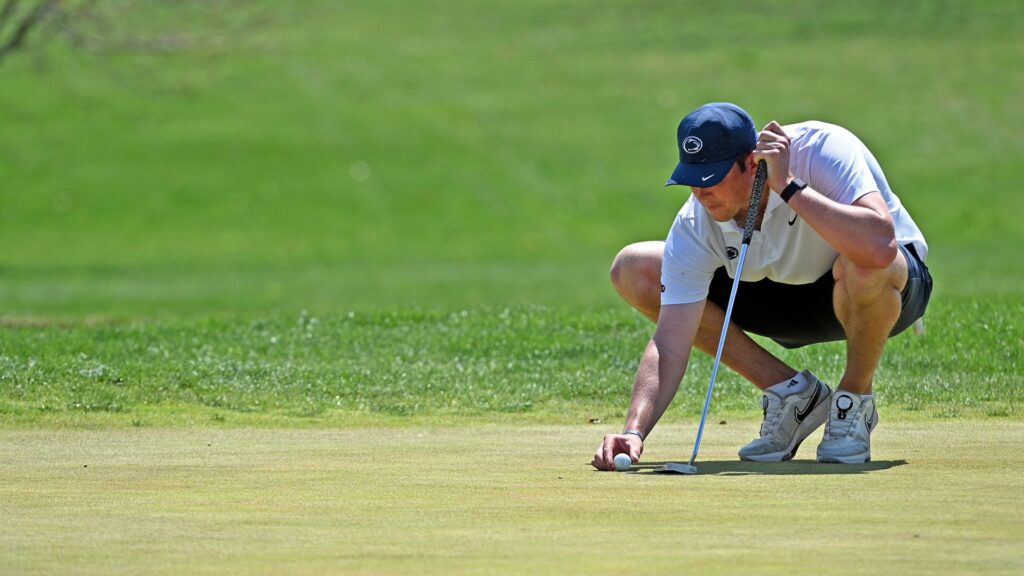Penn State’s golf courses have evolved from a rudimentary course of four or five holes in the late 1800s to the 18-hole Blue and White courses that the university operates today.
Those simple holes date to the era when the school was called the Pennsylvania State College. The school’s yearbook, La Vie, referred several times in the 1890s to an interest in the game. In 1898 a “Golf Department” was established.
Anecdotal evidence in La Vie and The Free Lance, the college’s newspaper from 1887 to 1904, suggests that golf was played on the abbreviated course, which likely was on the east part of the campus.

In 1901, the course was extended to nine holes and improved with red flags, tee markers, and “hole tins” (the cups in the holes). It became known as the Golf Club of State College.
In 1905, the Golf Department became the Golf Club. However, both the organization and course were short-lived as the college closed the golf course in 1908 and used the land to expand the campus.
Hugo Bezdek, who as the athletic director from 1918 to 1937 built a comprehensive athletic department, arranged for a new nine-hole golf course. In 1919, Bezdek hired Robert D. Pryde, a stalwart of golf in New England and a key figure in development of the game at Yale, to design the new course. The Nittany Course, on the west end of campus near the planned Recreation Building (better known today as Rec Hall) was completed in 1920.
Bezdek hired Robert “Pop” Rutherford to grow the game at Penn State. Rutherford coached the first Penn State golf team in 1922 and remained as coach until 1949. The annual Rutherford Intercollegiate Golf Tournament is held at Penn State in his honor.
Under Rutherford’s leadership, the popularity of the game increased dramatically. Moving to upgrade the course, Rutherford called on Willie Park Jr., the Scottish golf professional, two-time Open Champion, and renowned golf course architect. Park spent six days at Penn State in the fall of 1922. The result was the 18-hole Campus Course, one of Park’s first collegiate designs. It opened for play in 1924.
The Campus Course’s caddy house was demolished to make way for the Recreation Building, which was completed in 1928. A small office in Rec Hall then served as the pro shop. A commemorative plaque now adorns the door to the former shop, which is near the men’s locker room.
In 1964, plans for an additional course and new clubhouse facility were approved by the university. Designed by Ferdinand Garbin and James Harrison, the course was named the Blue Course. The course opened in 1970 and was operated from a pro shop accessed from a road off West College Avenue.
The Blue Course became the primary location for all intercollegiate events. Both courses remained largely unchanged until the early 1990s when Penn State joined the Big Ten Conference. To accommodate the plan to operate the courses out of a central facility, and to modernize the courses, Penn State hired golf course architects Ault, Clark & Associates.
The White Course redesign comprised nine of the original Willie Park Jr. holes, six Blue Course holes and three newly designed holes. The remaining six Willie Park Jr. holes were renamed the Nittany Course, a nod to the Rod D. Pryde course completed in 1920, and were open for play until 2002 when the university seized the land for what is now the White Course Apartments.
Holes six through 14 of the White Course are all that is left of Park’s design. Virtually untouched, the stretch of holes is among the oldest collegiate golf holes in the country.

The Blue Course redesign retained nine original holes and added an additional nine. In 1994, the redesigned Blue and White courses opened and operated out of the centrally located Walker Clubhouse named after Eric A. Walker, Penn State’s president from 1956 to 1970. The facility offered a 36-bay driving range, a chipping area, and practice greens.
In 2003, with hosting the Big Ten Conference Golf Championship in mind, the university hired golf course architect David Heatwole to rework Blue Course holes seven and eight, and to lengthen the White Course with several tee relocations.
In 2010, the Tombros Varsity Team Golf Clubhouse opened as did golf team grass tee practice areas and several putting and chipping practice areas.
The Blue Course hosted the 2008 Big Ten Women’s Championship, the 2009 Men’s Big Ten Championship and the 2012 NCAA Women’s Regional Tournament. In addition to the Rutherford Intercollegiate Golf Tournament, the courses annually host junior tournaments and events conducted by organizations such as the United States Golf Association (USGA) and the Professional Golfers Association (PGA) Junior series.
Notable professional golfers to compete at the Penn State courses include Arnold Palmer, who won the 1946 PIAA Championship, and Jim Furyk, who won the 1987 PIAA Championship.
Leon Valsechi
Sources:
La Vie, 1898, 1905.
The Free Lance, November 1, 1901.
The Daily Collegian, December 10, 1908, July 24, 1924.
Penn State Golf History, gopsusports.com (Accessed Feb. 27, 2023).
Penn State Golf Course and Facilities, gopsusports.com (Accessed Feb. 27, 2023).
Penn State Special Collections Library, RGN 28 UP Golf House 1900 Folder 01.
Penn State Special Collections Library, 00387 General Vertical Files, Golf Courses 1901-present.
First Published: May 18, 2023
Last Modified: March 7, 2024
